Evaluation and Correction Method of Asphalt Pavement Rutting Performance Prediction Model Based on RIOHTrack Long-Term Observation Data
Abstract
:1. Introduction
2. Objective and Scope
3. Methods
4. Overview of RIOHTrack Full-Scale Pavement Test Track
5. Rutting Prediction Model and Parameter Values of China’s Asphalt Pavement
6. Results and Discussion
6.1. Evaluation on Asphalt Pavement Rutting Prediction Model
- (1)
- For Structure I, the predicted value of the rutting model is relatively close to the measured value. The measured result fluctuates up and down near the prediction curve, and the error of the model prediction is small. For STR2 with the smallest error, the MSE is 1.12 mm2; the RMSE is 1.06 mm; the MAE is 0.85 mm; and the MAPE is 17.6%. The R2 of STR1 and STR2 rutting models are 0.6346 and 0.6223, respectively. According to [12], the R2 of the predicted value of the model and the measured value in MEPDG is 0.6425. For Structure I, the accuracy of the rutting model in China’s Specifications is basically equivalent to that in American MEPDG, and the model has a similar prediction effect.
- (2)
- For Structures II and VII, the correlation between the predicted value of the rutting model and the measured value is similar. A great difference is observed between the predicted value and the measured value of the rutting model with the two categories of structures. The predicted value is significantly larger than the measured value. The predicted curve is above the measured value. In addition, with the increase in the cumulative number of ESALs, the error in the model prediction rises. For STR5 with the smallest error, the MSE is 3.67 mm2; the RMSE is 1.92 mm; the MAE is 1.69 mm; and the MAPE is 32.1%. The R2 of STR4, STR5, STR18, and STR19 structural rutting models, namely, −8.2491, −1.2133, −0.0792, and −1.0787, respectively, are all negative. According to the meaning of the determination coefficient R2, when R2 is negative, the effect of the simulated prediction is poor and even cannot reach the prediction accuracy of the average value curve of the measured value. Therefore, for Structures II and VII, the accuracy of the rutting model in China’s Specifications is relatively poor. This model is not suitable for the rutting prediction. The reason for this phenomenon may be that the characteristics of the two structures are not fully considered when Equation (3) is established, thereby resulting in the poor prediction effect of the model. Figure 2 shows that Structure II belongs to the rigid base asphalt pavement. The lean concrete or cement concrete is adopted for the base, and the modulus and strength of the base are relatively high in value. Structure VII belongs to the full-depth asphalt pavement structure with the thickness of asphalt materials reaching 48–52 cm. According to [3], the rutting model in China’s Specifications is established on the basis of the rutting data of 10 highways and 5 test sections. Semi-rigid materials are used as the base or subbase of more than 95% of asphalt pavement in China, and the thickness of the asphalt concrete structural layer generally does not exceed 30 cm. Therefore, to make the rutting model in the design specification more widely applicable, semi-rigid materials are used as the base in the construction of 10 highways and 5 test sections used in the model, and the thickness of the asphalt concrete is in the range of 16–28 cm. When establishing Equation (3), Structure II, which has lean concrete or cement concrete as the base, and Structure VII, which has 48–52 cm-thick asphalt material layer thickness, are not considered, which is also the main reason for the poor prediction effect of Equation (3) on the two kinds of structures.
- (3)
- For Structure III and STR10 in Structure IV, the predicted value is significantly larger than the measured value. The predicted curve is below the measured value. After the initial loading stage (Ne is about 5 million), the predicted curve is basically parallel to the measured curve, and the difference between the predicted value and the measured value is basically constant with the increase in cumulative ESALs. For STR7 with the smallest error, the MSE is 3.52 mm2; the RMSE is 1.88 mm; the MAE is 1.64 mm; and the MAPE is 25.2%. The R2 of STR7, STR8, and STR10 structural rutting models are 0.3337, 0.2222, and 0.0469, respectively. R2 is in the range of 0–0.4. The prediction effect is not ideal.
- (4)
- For the remaining structures, namely, STR12 in Structures IV, V, and VI, an intersection between the model prediction curve and the measured curve of the rutting model exists with the increase in ESALs. Therefore, it can be obviously divided into two stages. The first stage is the first section of the whole rutting evolution curve. When the ESALs reach a certain critical value (Ne′) from 0 at the beginning, the predicted value of the rutting model is obviously less than the measured value. However, with the increase in ESALs, the error of the model prediction gradually becomes small. When it reaches the critical value (Ne′) of ESALs, the predicted value is almost the same as the measured value. The second stage is the latter section of the whole rutting evolution curve. When the number of ESALs is greater than the critical value (Ne′), the predicted value of the rutting model is higher than the measured value. With the increase in ESALs, the model prediction error gradually rises. For different structures, the critical values (Ne′) of ESALs vary greatly. For STR17 with the smallest error, the MSE is 1.72 mm2; the RMSE is 1.31 mm; the MAE is 1.15 mm; and the MAPE is 23.1%. The critical values (Ne′) of STR12, STR11, STR13, STR16, and STR17 are 35 million, 50 million, 30 million, 45 million, and 25 million, respectively. The R2 of five structural rutting models are 0.0860, 0.4220, 0.2500, 0.0444, and 0.2084. R2 is in the range of 0–0.5. The prediction effect is not ideal. From the meaning of the R2, although the rutting model can be used to predict these structures with R2 between 0 and 0.5, the accuracy is not high. The main reason is that the rutting observation data in this research are based on the RIOHTrack accelerated loading test. Compared with 10 highways and 5 test sections used for establishing the model in China’s Specification, some differences are observed in the geographical location, climate environment, and traffic load, etc. A local correction coefficient should be introduced into the rutting model by referring to [26,27,28,29,30,31,32,33], and the model must be modified to obtain a rutting prediction model suitable for the location of the RIOHTrack, thereby improving the accuracy of model prediction.
6.2. Correction of Asphalt Pavement Rutting Prediction Model
- (1)
- On the basis of the existing rutting performance prediction model Equation (3) in China, the local correction coefficients β1, β2, and β3 are introduced to improve a new rutting prediction model; see Equation (7). Among them, β1 is used to correct the constant term of the existing rutting model, β2 is used to correct the exponential term of the temperature, and β3 is used to correct the exponential term of the cumulative ESALs.
- (2)
- Relying on local projects and test sections, long-term observation of rutting deformation of asphalt pavement is carried out, and the measured rutting data with the cumulative ESALs are obtained. These data can reflect the long-term evolution of pavement rutting under the combined effect of multiple factors such as local climate environment, traffic load, pavement structure, and material type.
- (3)
- Based on the long-term observation results of rutting deformation, a new rutting prediction model after correction is used to fit the rutting data according to the least squares method, so the local correction coefficients β1, β2, and β3 can be obtained, and the model prediction errors are obtained to judge the model accuracy. Finally, taking these coefficients into Equation (7), the new rutting prediction model after local correction can be obtained.
7. Conclusions
- (1)
- The rutting model in China’s Specifications for Design of Highway Asphalt Pavement has significant structural dependence. Different structures are predicted using a unified rutting model with different prediction accuracies.
- (2)
- The existing rutting model is used for prediction. Structure I has the highest accuracy and the smallest error, and the R2 is greater than 0.6. Rigid base and full-depth asphalt pavement structures have the worst accuracy, and the R2 is negative. The prediction accuracy of other structures is not high, and the R2 is in the range of 0–0.5.
- (3)
- To improve prediction accuracy, local correction coefficients are introduced in the existing rutting prediction model to establish a new one. The RIOHTrack rutting measured value is adopted to fit the new rutting prediction model, and the local correction coefficients of different structures are obtained.
- (4)
- After local correction, the accuracy of the rutting prediction model of all structures is greatly improved. The R2 values are greater than 0.87. The predicted values of the rutting models with these structures are relatively close to the measured values. The measured result fluctuates up and down near the prediction curve, the error of the model prediction declines, and the accuracy is improved significantly.
- (5)
- The measured rutting data in this research are the test results under the combined effect of local climate environment, traffic load, pavement structure, and material type. On the basis of this test data, the new rutting prediction model obtained after local correction will also have higher regional applicability, and is more suitable for rutting prediction of various pavement structures in the area where the RIOHTrack is located, and the accuracy is also higher.
Author Contributions
Funding
Institutional Review Board Statement
Informed Consent Statement
Data Availability Statement
Conflicts of Interest
References
- AASHTO. Mechanistic-Empirical Pavement Design Guide: A Manual of Practice, Interim Edition; American Association of State Highway and Transportation Officials: Washington, DC, USA, 2008. [Google Scholar]
- Shell. Pavement Design Manual; Shell International Petroleum Company, Ltd.: London, UK, 1978. [Google Scholar]
- Ministry of Transport of the People’s Republic of China. Specifications for Design of Highway Asphalt Pavement; China Communications Press: Beijing, China, 2017.
- Tseng, K.H.; Lytton, R.L. Prediction of Permanent Deformation in Flexible Pavement Materials; American Society for Testing and Materials: West Conshohocken, PA, USA, 1989. [Google Scholar]
- Yao, Z.K. Structural Design of Asphalt Pavements; China Communications Press: Beijing, China, 2011. [Google Scholar]
- Van de Loo, P.J. Practical approach to the prediction of rutting in asphalt pavements: The Shell method. Transp. Res. Rec. 1976, 616, 15–21. [Google Scholar]
- Van de Loo, P.J. Creep test: A key tool in asphalt mix evaluation and in prediction of rutting. J. Assoc. Asph. Paving Technol. 1978, 47, 522–557. [Google Scholar]
- Zhang, J.; Cooley, L.A., Jr.; Kandhal, P.S. Comparison of fundamental and simulative test methods for evaluating permanent deformation of hot mix asphalt. Transp. Res. Rec. 2002, 1789, 91–100. [Google Scholar] [CrossRef] [Green Version]
- Monismith, C.L.; Hicks, R.G.; Finn, F.N.; Sousa, J.; Harvey, J.; Weissman, S.; Deacon, J.; Coplantz, J.; Paulsen, G. Permanent Deformation Response of Asphalt Aggregate Mixes; Report SHRP-A-415; Strategic Highway Research Program, National Research Council: Washington, DC, USA, 1994. [Google Scholar]
- Monismith, C.L.; Epps, J.A.; Finn, F.N. Improved asphalt mix design. J. Assoc. Asph. Paving Technol. 1985, 54, 340–406. [Google Scholar]
- El-Basyouny, M.M.; Witczak, M.; Zapata, C.E. Development of asphalt concrete rutting model using permanent strain database. In Proceedings of the Transportation Research Board 86th Annual Meeting, Washington, DC, USA, 21–25 January 2007. [Google Scholar]
- National Cooperative Highway Research Program. Guide for Mechanistic-Empirical Design of New and Rehabilitated Pavement Structures, Final Document, Appendix GG-1: Calibration of Permanent Deformation Models for Flexible Pavements; National Cooperative Highway Research Program: Champaign, IL, USA, 2004. [Google Scholar]
- Kaloush, K.E.; Witczak, M.W. Tertiary flow characteristics of asphalt mixtures. J. Assoc. Asph. Paving Technol. 2002, 71, 248–280. [Google Scholar]
- Kandhal, P.S.; Mallick, R.B. Effect of mix gradation on rutting potential of dense-graded asphalt mixtures. Transp. Res. Rec. 2001, 1767, 146–151. [Google Scholar] [CrossRef]
- Yang, Z.; He, D. Summarizing and Improving of Rut Pre Evaluating Method in Asphalt Pavement. J. East North Highw. 2001, 24, 12–15. [Google Scholar]
- Verstraeten, J.; Veverka, V.; Francken, L. Rational and Practical Designs of Asphalt Pavements to Avoid Cracking and Rutting. In Proceedings of the 5th International Conference on the Structural Design of Asphalt Pavements, Delft, The Netherlands, 23–26 August 1982. [Google Scholar]
- Zhang, D.; Li, J. Prediction of Rutting in Asphalt Pavement. China J. Highw. Transp. 1995, 8, 23–29. [Google Scholar]
- Kenis, W.; Sherwood, J.; McMahon, T. Verification and Application of the Vesys Structural Subsystem. In Proceedings of the 5th International Conference on the Structural Design of Asphalt Pavements, Delft, The Netherlands, 23–26 August 1982. [Google Scholar]
- Kim, H.B.; Buch, N.; Park, D. Mechanistic-empirical rut prediction model for in-service pavements. Transp. Res. Rec. 2000, 1730, 99–109. [Google Scholar] [CrossRef]
- Kim, M.; Mohammad, L.; Elseifi, M. Effects of Various Extrapolation Techniques for Abbreviated Dynamic Modulus Test Data on the MEPDG Rutting Predictions. J. Mar. Sci. Technol. 2015, 23, 353–363. [Google Scholar]
- Shami, H.I.; Lai, J.S.; D’angelo, J.A.; Harman, T.P. Development of Temperature-Effect Model for Predicting Rutting of Asphalt Mixtures Using Georgia Loaded Wheel Tester. Transp. Res. Rec. 1997, 1590, 17–22. [Google Scholar] [CrossRef]
- Monismith, C.L.; McLean, D.B.; Ogawa, N. Design Considerations for Asphalt Pavements; FHWA-CA-77-D-6-1; Federal Highway Administration: Berkley, CA, USA, 1978.
- Monismith, C.L.; Tayebali, A.A. Permanent deformation (rutting) consideration in asphalt concrete pavement sections (with discussion and closure). J. Assoc. Asph. Paving Technol. 1988, 57, 414–463. [Google Scholar]
- Wijeratne, A.; Sargious, M. Prediction of Rutting in Virgin and Recycled Asphalt Mixtures for Pavement Using Triaxial Tests. J. Assoc. Asph. Paving Technol. 1987, 56, 111–129. [Google Scholar]
- Huang, X.; Zhang, X.; Deng, X. Asphalt Pavement Rutting Prediction of High-Grade Highway. J. Southeast Univ. (Nat. Sci. Ed.) 2000, 30, 96–101. [Google Scholar]
- Wang, H.; Zhang, C.; You, Z. Calibration of rutting prediction model in MEPDG based on mathematical statistics method. J. Chang. Univ. (Nat. Sci. Ed.) 2013, 33, 1–7. [Google Scholar]
- Liu, W.; Lin, Z. Study on area correction factor of rutting prediction model for flexible base asphalt pavement based on MEPDG. J. Highw. Transp. Res. Dev. 2017, 34, 67–70. [Google Scholar]
- Retherford, J.; Mcdonald, M. Reliability Methods Applicable to Mechanistic-Empirical Pavement Design Method. Transp. Res. Rec. J. Transp. Res. Board 2010, 2154, 130–137. [Google Scholar] [CrossRef]
- Hoegh, K.; Khazanovich, L.; Jensen, M. Local Calibration of MEPDG Rutting Model for MnROAD Test Sections. Transp. Res. Rec. J. Transp. Res. Board 2010, 2180, 130–141. [Google Scholar] [CrossRef]
- Muthadi, N.; Kim, Y. Local Calibration of Mechanistic-Empirical Pavement Design Guide for Flexible Pavement Design. Transp. Res. Rec. J. Transp. Res. Board 2008, 2087, 131–141. [Google Scholar] [CrossRef]
- Seitllari, A.; Lanotte, M.; Kutay, M. Recommended Calibration Procedure of MEPDG Asphalt Rutting Model Using Repeated Load Permanent Deformation and Confined and Unconfined Dynamic Modulus Data. J. Transp. Eng. Part B Pavements 2020, 147, 04020079. [Google Scholar] [CrossRef]
- Jannat, G.; Yuan, X.; Shehata, M. Development of regression equations for local calibration of rutting and IRI as predicted by the MEPDG models for flexible pavements using Ontario’s long-term PMS data. Int. J. Pavement Eng. 2016, 17, 166–175. [Google Scholar] [CrossRef]
- Hassan, H.; Baaj, H.; Kadhim, H. Calibration of MEPDG permanent deformation models using Hamburg Wheel Rut Tester and field data. Int. J. Pavement Eng. 2021. [Google Scholar] [CrossRef]
- AASHTO. Mechanistic-Empirical Pavement Design Guide: A Manual of Practice, 2nd ed.; American Association of State Highway and Transportation Officials: Washington, DC, USA, 2015. [Google Scholar]
- AASHTO. Mechanistic-Empirical Pavement Design Guide: A Manual of Practice, 3rd ed.; American Association of State Highway and Transportation Officials: Washington, DC, USA, 2020. [Google Scholar]
- Wang, X. Design of Pavement Structure and Material for Full-scale Test Track. J. Highw. Transp. Res. Dev. 2017, 34, 30–37. [Google Scholar]
- Wang, X.D.; Zhang, L.; Zhou, X.Y.; Xiao, Q.; Wei, G. Review of Researches of RIOHTrack in 2017. J. Highw. Transp. Res. Dev. 2017, 35, 5–13. [Google Scholar]
- Zhang, L.; Zhou, X.; Wang, X. Research progress of long-life asphalt pavement behavior based on the RIOHTrack full-scale accelerated loading test. Chin. Sci. Bull. 2020, 65, 3247–3258. [Google Scholar] [CrossRef]
- Wang, X.D.; Zhang, L.; Zhou, X.Y.; Xiao, Q.; Guan, W.; Shan, L.Y. Research progress of RIOHTrack in China. In Accelerated Pavement Testing to Transport Infrastructure Innovation; Springer: Cham, Switzerland, 2020. [Google Scholar]
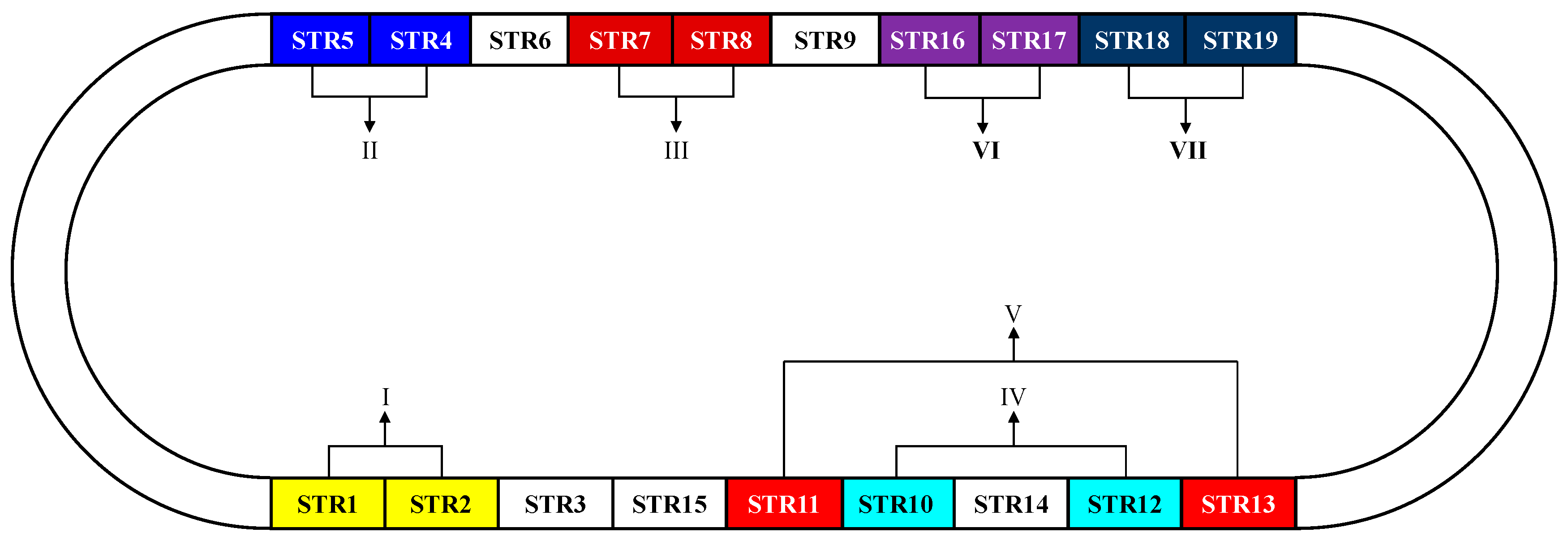
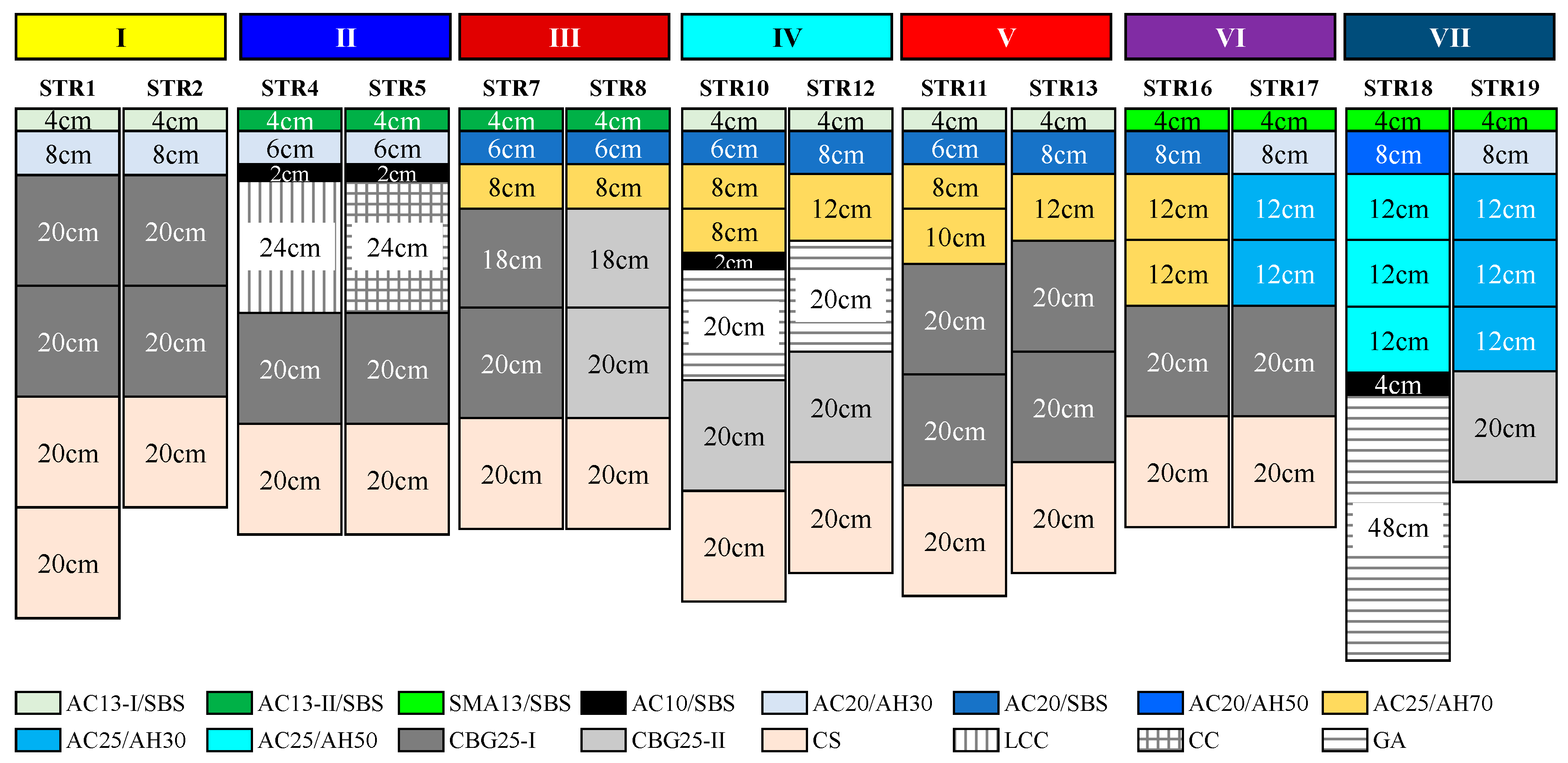

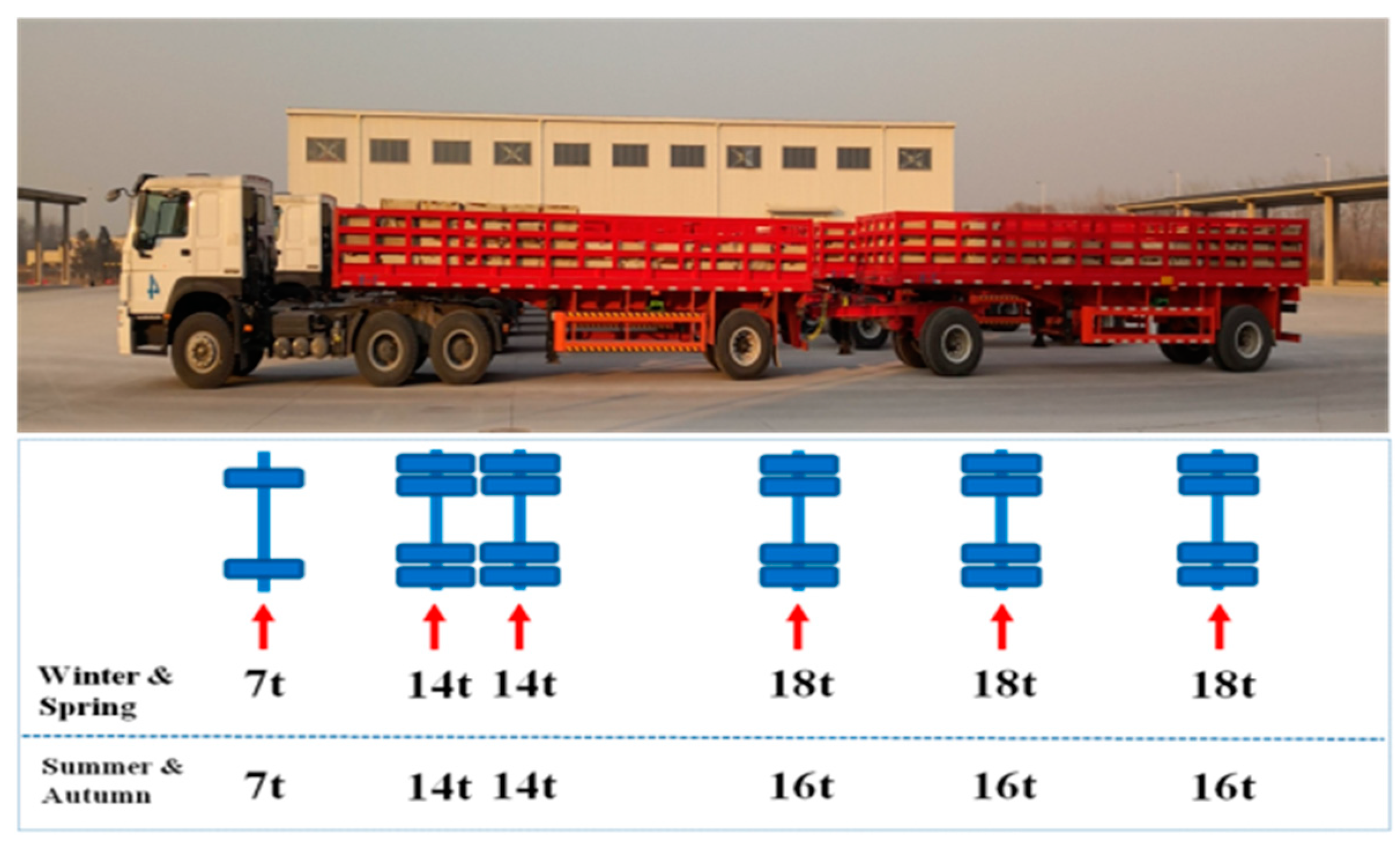
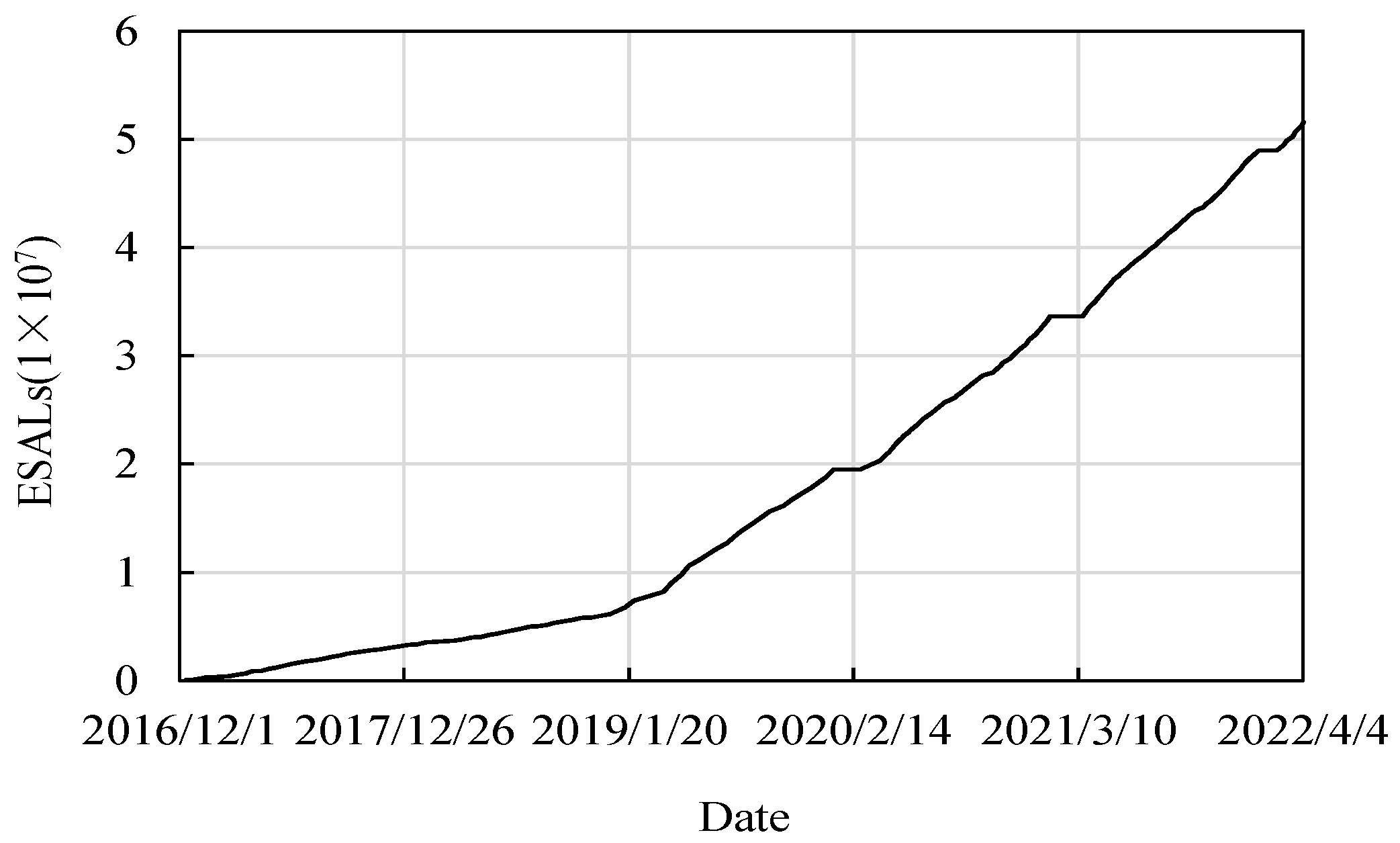


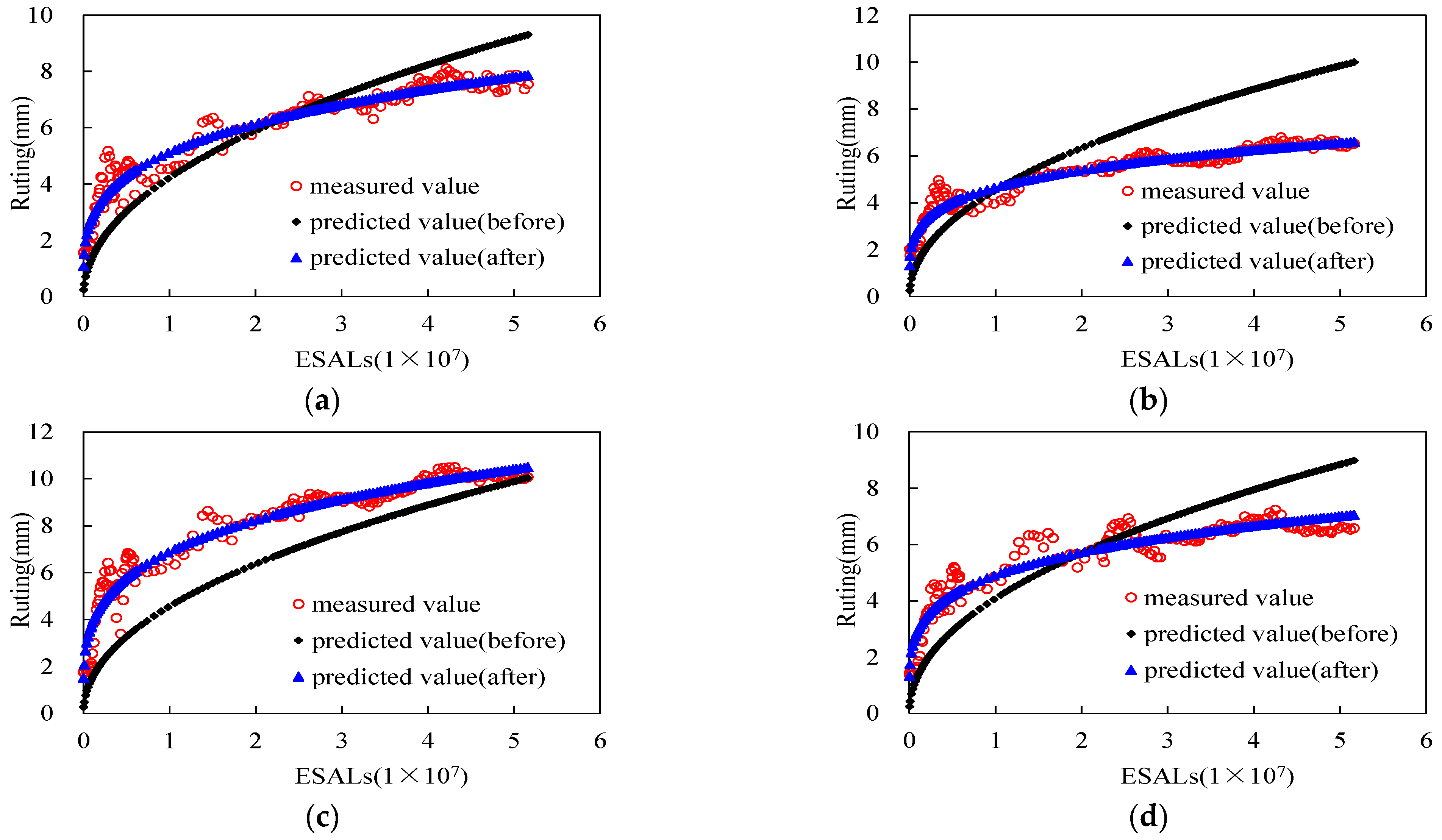
| AC Type | AC10 | AC13-I | AC13-II | SMA13 | AC20 | AC20 | AC20 | AC25 | AC25 | AC25 |
|---|---|---|---|---|---|---|---|---|---|---|
| Asphalt Type | SBS | SBS | SBS | SBS | AH30 | AH50 | SBS | AH30 | AH50 | AH70 |
| Permanent Deformation (mm) | 2.40 | 1.54 | 1.65 | 1.82 | 1.70 | 2.67 | 1.30 | 1.96 | 2.12 | 2.82 |
| Structure Type | MSE | RMSE | MAE | MAPE | R2 | |
|---|---|---|---|---|---|---|
| Unit | mm2 | mm | mm | - | - | |
| I | STR1 | 1.16 | 1.08 | 0.91 | 18.3% | 0.6346 |
| STR2 | 1.12 | 1.06 | 0.85 | 17.6% | 0.6223 | |
| II | STR4 | 7.70 | 2.78 | 2.40 | 53.7% | −8.2491 |
| STR5 | 3.67 | 1.92 | 1.69 | 32.1% | −1.2133 | |
| III | STR7 | 3.52 | 1.88 | 1.64 | 25.2% | 0.3337 |
| STR8 | 5.68 | 2.38 | 2.29 | 30.9% | 0.2222 | |
| IV | STR10 | 5.63 | 2.37 | 2.20 | 30.5% | 0.0469 |
| STR12 | 3.09 | 1.76 | 1.35 | 23.0% | 0.0860 | |
| V | STR11 | 2.89 | 1.70 | 1.43 | 23.1% | 0.4220 |
| STR13 | 2.45 | 1.56 | 1.26 | 21.8% | 0.2500 | |
| VI | STR16 | 2.67 | 1.63 | 1.31 | 24.4% | 0.0444 |
| STR17 | 1.72 | 1.31 | 1.15 | 23.1% | 0.2084 | |
| VII | STR18 | 7.23 | 2.69 | 2.20 | 25.3% | −0.0792 |
| STR19 | 5.51 | 2.35 | 2.01 | 31.8% | −1.0787 | |
| Structure Type | I | II | III | IV | V | VI | VII | |||||||
|---|---|---|---|---|---|---|---|---|---|---|---|---|---|---|
| STR1 | STR2 | STR4 | STR5 | STR7 | STR8 | STR10 | STR12 | STR11 | STR13 | STR16 | STR17 | STR18 | STR19 | |
| RIOHTrack Measured values (mm) | 7.70 | 7.89 | 5.15 | 6.40 | 9.99 | 11.60 | 10.69 | 8.90 | 10.05 | 8.50 | 7.89 | 6.63 | 10.45 | 7.36 |
| Model Predicted Values (mm) | 9.20 | 9.19 | 9.69 | 9.87 | 9.91 | 9.85 | 9.57 | 9.28 | 10.02 | 9.91 | 8.25 | 8.86 | 15.72 | 11.96 |
| MAPE (%) | 19.5 | 16.5 | 88.1 | 54.2 | 0.8 | 15.1 | 10.5 | 4.3 | 0.4 | 16.6 | 4.5 | 33.8 | 50.5 | 62.5 |
| Structure Type | β1 | β2 | β3 | MSE | RMSE | MAE | MAPE | R2 | |
|---|---|---|---|---|---|---|---|---|---|
| I | STR1 | 6.1319 | 1.2123 | 0.5440 | 0.21 | 0.46 | 0.38 | 8.6% | 0.9331 |
| STR2 | 6.1201 | 1.2120 | 0.5425 | 0.18 | 0.42 | 0.31 | 7.4% | 0.9400 | |
| II | STR4 | 9.4764 | 1.2749 | 0.3677 | 0.11 | 0.33 | 0.24 | 6.6% | 0.8722 |
| STR5 | 7.5312 | 1.2573 | 0.4409 | 0.13 | 0.36 | 0.26 | 6.4% | 0.9237 | |
| III | STR7 | 7.0638 | 1.2254 | 0.5330 | 0.31 | 0.56 | 0.40 | 8.2% | 0.9415 |
| STR8 | 5.4336 | 1.1970 | 0.6079 | 0.30 | 0.55 | 0.39 | 7.5% | 0.9591 | |
| IV | STR10 | 7.2853 | 1.2287 | 0.5340 | 0.47 | 0.69 | 0.49 | 10.1% | 0.9203 |
| STR12 | 10.0245 | 1.2674 | 0.4357 | 0.41 | 0.64 | 0.48 | 10.6% | 0.8787 | |
| V | STR11 | 7.0344 | 1.2237 | 0.5301 | 0.34 | 0.59 | 0.46 | 8.7% | 0.9311 |
| STR13 | 9.6484 | 1.2624 | 0.4367 | 0.31 | 0.56 | 0.42 | 9.2% | 0.9045 | |
| VI | STR16 | 9.9075 | 1.2660 | 0.4412 | 0.31 | 0.55 | 0.39 | 10.0% | 0.8901 |
| STR17 | 8.2984 | 1.2436 | 0.4598 | 0.24 | 0.49 | 0.38 | 9.6% | 0.8913 | |
| VII | STR18 | 4.8346 | 1.1941 | 0.5643 | 0.46 | 0.68 | 0.52 | 10.8% | 0.9312 |
| STR19 | 6.9198 | 1.2416 | 0.4625 | 0.25 | 0.50 | 0.37 | 7.9% | 0.9073 | |
Publisher’s Note: MDPI stays neutral with regard to jurisdictional claims in published maps and institutional affiliations. |
© 2022 by the authors. Licensee MDPI, Basel, Switzerland. This article is an open access article distributed under the terms and conditions of the Creative Commons Attribution (CC BY) license (https://creativecommons.org/licenses/by/4.0/).
Share and Cite
Wu, Y.; Zhou, X.; Wang, X.; Ma, Z. Evaluation and Correction Method of Asphalt Pavement Rutting Performance Prediction Model Based on RIOHTrack Long-Term Observation Data. Appl. Sci. 2022, 12, 6805. https://doi.org/10.3390/app12136805
Wu Y, Zhou X, Wang X, Ma Z. Evaluation and Correction Method of Asphalt Pavement Rutting Performance Prediction Model Based on RIOHTrack Long-Term Observation Data. Applied Sciences. 2022; 12(13):6805. https://doi.org/10.3390/app12136805
Chicago/Turabian StyleWu, Yang, Xingye Zhou, Xudong Wang, and Zhimin Ma. 2022. "Evaluation and Correction Method of Asphalt Pavement Rutting Performance Prediction Model Based on RIOHTrack Long-Term Observation Data" Applied Sciences 12, no. 13: 6805. https://doi.org/10.3390/app12136805
APA StyleWu, Y., Zhou, X., Wang, X., & Ma, Z. (2022). Evaluation and Correction Method of Asphalt Pavement Rutting Performance Prediction Model Based on RIOHTrack Long-Term Observation Data. Applied Sciences, 12(13), 6805. https://doi.org/10.3390/app12136805





